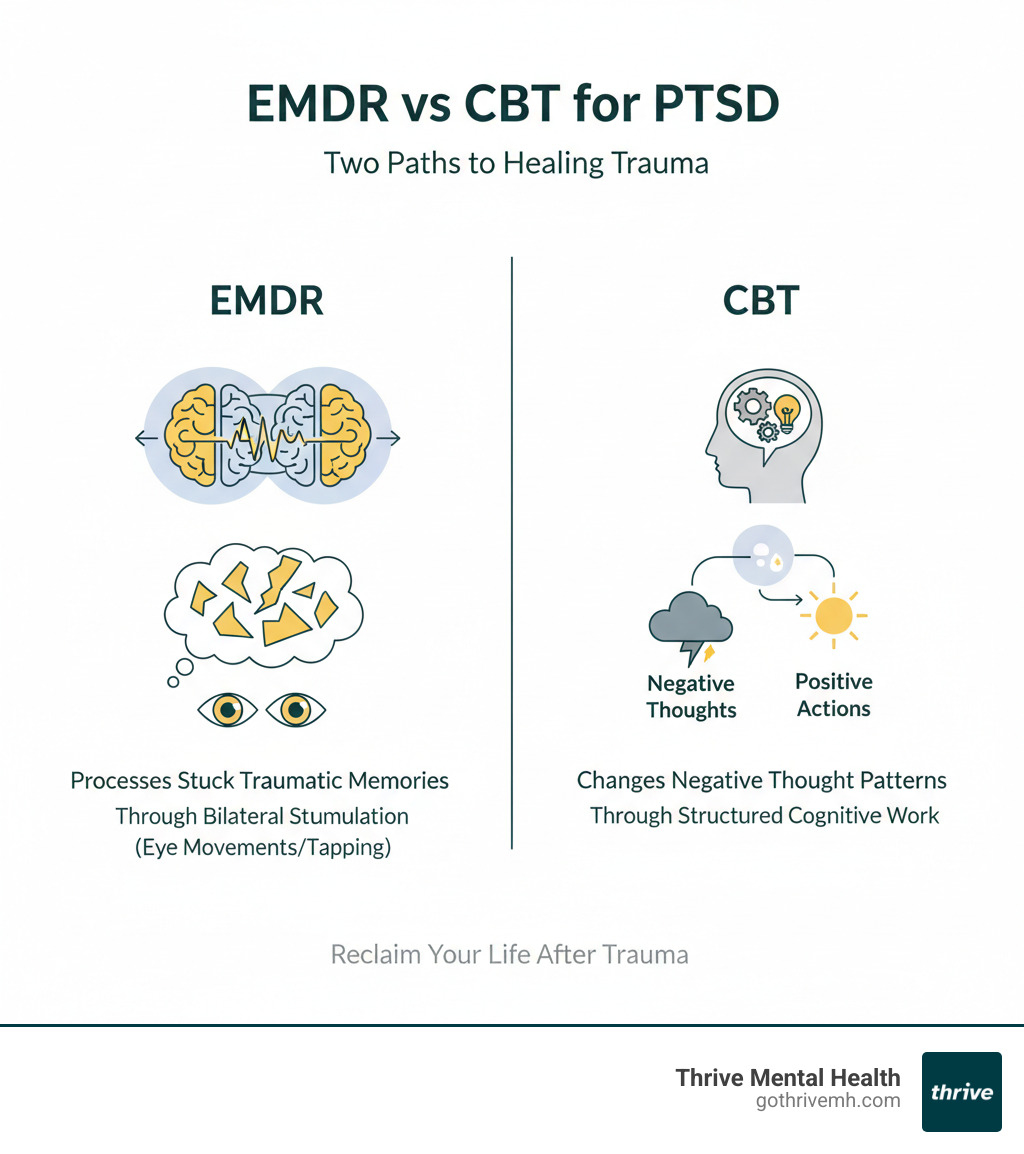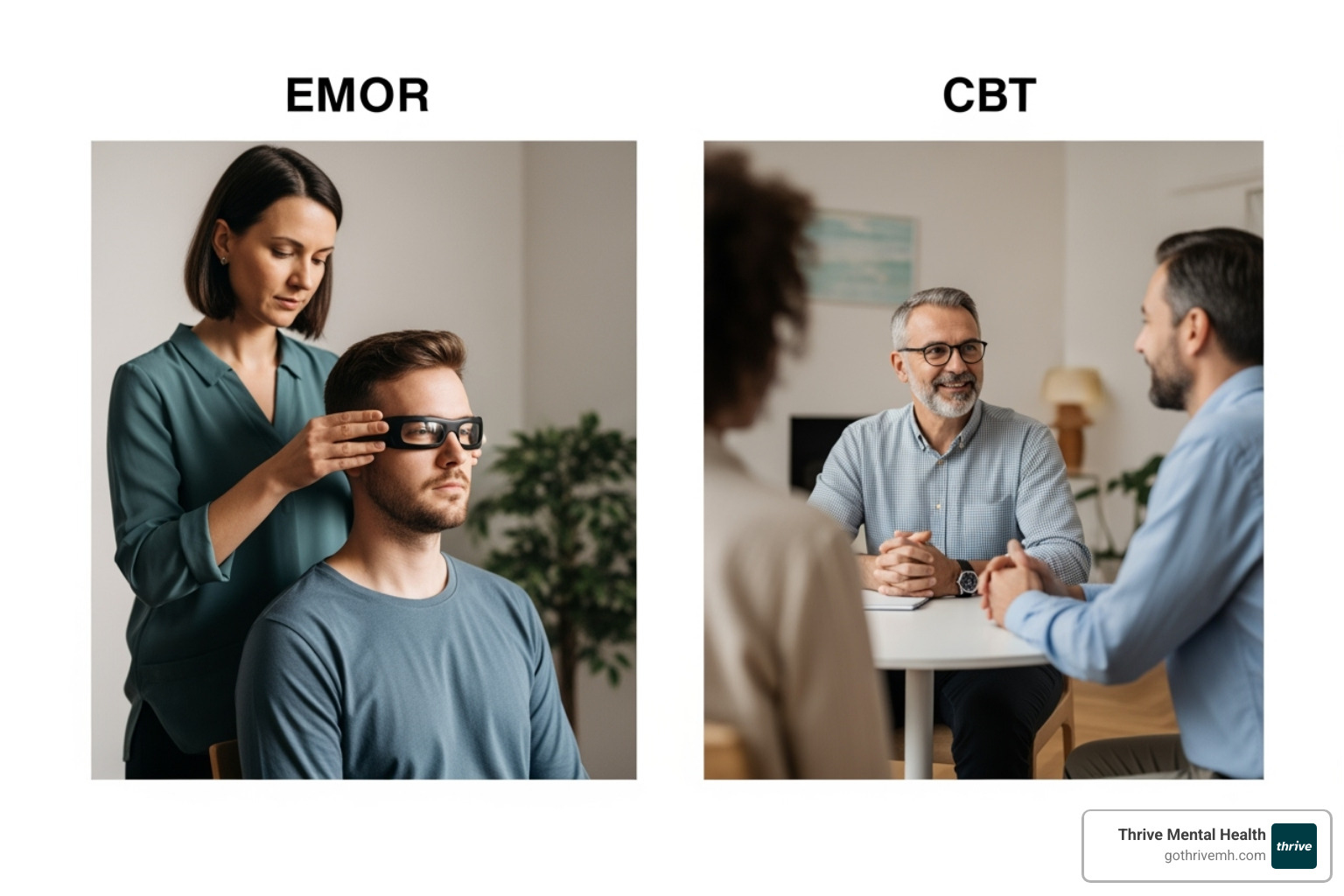Eye Movements or Mind Shifts? Picking EMDR or CBT for PTSD

EMDR vs CBT for PTSD: Top 5 Healing Choices
Your Path to Healing from PTSD
EMDR vs CBT for PTSD – two evidence-based therapies that can help you reclaim your life after trauma. But which one is right for you?
If you’re in crisis or need immediate support, call or text the 988 Suicide & Crisis Lifeline. You are not alone.
Here’s what you need to know:
EMDR (Eye Movement Desensitization and Reprocessing)
- Processes traumatic memories through eye movements or tapping
- Less talking required – focuses on reprocessing “stuck” memories
- Often shows faster initial results
- Better for reducing anxiety symptoms
CBT (Cognitive Behavioral Therapy)
- Changes negative thought patterns and behaviors
- More structured with homework assignments
- Builds practical coping skills
- Equal effectiveness for depression symptoms
The Research Shows:
- EMDR is more effective for immediate PTSD symptom relief
- EMDR significantly outperforms CBT for anxiety reduction
- No difference between therapies for depression treatment
- Long-term outcomes are similar at 3-month follow-up
Choosing between therapies for PTSD can feel overwhelming, especially if talk therapy hasn’t worked or you’re not ready to relive your trauma. The good news is that both EMDR and CBT are proven treatments—the key is finding what works for your needs.
About Your Guide
I’m Anna Green, LMHC, LPC, Chief Clinical Officer at Thrive Mental Health, with specialized training in EMDR and extensive experience helping individuals across Florida steer the choice between EMDR vs CBT for PTSD. Through my work with complex trauma presentations and recovery-oriented care, I’ve seen how the right therapeutic approach can transform lives.

Basic emdr vs cbt for ptsd glossary:
What is EMDR Therapy? Reprocessing Trauma Without Words
When you’re struggling with trauma, sometimes talking about it feels impossible. That’s where Eye Movement Desensitization and Reprocessing (EMDR) comes in—a therapy that helps you heal without having to verbally relive every painful detail.
Developed by Dr. Francine Shapiro in the 1980s, EMDR emerged from her findy that eye movements could lessen the distress of disturbing thoughts. This led to a groundbreaking therapy now recognized as one of the most effective for PTSD.
The science behind EMDR is the Adaptive Information Processing (AIP) model. It suggests that trauma overwhelms the brain’s ‘filing system.’ Traumatic memories get stuck in the emotional brain (amygdala) instead of being processed by the logical brain (prefrontal cortex).
These stuck memories keep triggering your fight-or-flight response, even when you’re safe. That’s why you might have flashbacks, nightmares, or feel panicked by seemingly normal situations. EMDR helps unstick these memories so your brain can file them away properly.
Bilateral stimulation is EMDR’s secret weapon. While you briefly focus on the traumatic memory, your therapist guides you through rhythmic eye movements, sounds, or gentle tapping. This back-and-forth stimulation helps your emotional brain (amygdala) communicate with your logical brain (prefrontal cortex), building a bridge between the two parts of your brain that trauma disconnected.
What makes EMDR unique in the EMDR vs CBT for PTSD comparison is that it requires less verbalization. You don’t need to tell your story in detail. The healing happens through internal processing, making it especially helpful for people who find traditional talk therapy overwhelming.

Many people notice relief after just a few sessions. EMDR sessions typically last 60 to 90 minutes and follow a structured approach that keeps you feeling safe and in control.
To learn more about the techniques involved, explore our article on Exploring EMDR Therapy Techniques for Trauma Recovery.
The 8 Phases of EMDR Treatment
EMDR follows a careful 8-phase protocol to guide you safely through healing:
1. History & Treatment Planning: Your therapist learns your history to identify target memories and create a treatment plan.
2. Preparation: You’ll learn coping and grounding techniques to manage distress, building a ‘toolbox’ for emotional stability.
3. Assessment: You’ll select a target memory, identify the negative belief it created, choose a positive belief to replace it, and rate your distress on the Subjective Units of Disturbance (SUD) scale (0-10).
4. Desensitization: Bilateral stimulation (e.g., eye movements) begins while you focus on the memory. Your therapist monitors your SUD level as the memory’s emotional charge lessens.
5. Installation: Once distress is low, bilateral stimulation is used to strengthen your new, positive belief.
6. Body Scan: You’ll scan your body for any lingering physical tension, as trauma can be stored physically.
7. Closure: Each session ends with techniques to ensure you feel calm and stable before leaving.
8. Re-evaluation: The next session begins by reviewing your progress with processed memories to ensure healing is maintained and to plan the next steps.
This structured approach means your therapist guides you every step of the way toward reclaiming your life from trauma.
What is CBT? Shifting Your Mindset to Overcome PTSD
When you’re struggling with PTSD, your thoughts can feel like they’re working against you. That’s where Cognitive Behavioral Therapy (CBT) comes in—a proven approach that helps you change the connection between your thoughts, feelings, and behaviors.
Pioneered by Dr. Aaron Beck, CBT is based on the idea that our thoughts shape our feelings and actions. Unlike EMDR, CBT primarily aims to shift negative thought patterns and behaviors.
If EMDR helps your brain file away traumatic memories, CBT teaches you how to respond differently when those memories surface. It’s a collaborative “talk therapy” where you and your therapist work together to learn practical strategies for managing your symptoms.
CBT is structured and goal-oriented, making it effective for PTSD as well as anxiety, depression, and substance abuse. It helps you confront and alter the harmful thought cycles linked to trauma.
A hallmark of CBT is homework assignments—practice exercises between sessions. This might involve journaling, relaxation techniques, or behavioral experiments. While some love this structured approach, others find it challenging, which is completely normal.
Trauma-Focused CBT (TF-CBT) gives you concrete tools for daily life. Prolonged Exposure (PE), a specialized form of CBT, helps you gradually face trauma-related triggers in a safe, controlled way.

Find more about how this therapy can empower you in our guide, How CBT Can Transform Mental Health: A Comprehensive Guide.
Core Techniques of CBT for Trauma
CBT for trauma uses several powerful techniques to help you heal:
Identifying negative thoughts is your first step. You’ll learn to recognize negative thoughts linked to trauma, such as “It was my fault” or “I’m worthless.”
Challenging unhelpful beliefs through cognitive restructuring is next. You and your therapist examine the evidence for these thoughts, helping you replace them with more balanced perspectives.
Developing coping skills gives you a practical toolkit. You’ll learn relaxation techniques (like deep breathing), mindfulness, and problem-solving skills.
Gradually facing triggers through exposure therapy helps you safely confront trauma-related memories and situations, teaching your brain they are no longer dangerous.
Problem-solving skills and behavioral activation help you tackle current challenges and re-engage in positive activities, breaking the cycle of avoidance common in PTSD.
At its heart, CBT maintains a talk therapy focus, with you and your therapist working together in structured dialogue to develop strategies for lasting change.
Head-to-Head Comparison: EMDR vs. CBT for PTSD
When choosing between emdr vs cbt for ptsd, it helps to know they are two highly effective but different paths to healing.
EMDR focuses on reprocessing traumatic memories to reduce their emotional punch using bilateral stimulation (like eye movements). CBT focuses on identifying and changing negative thought patterns through cognitive restructuring and behavioral changes.
Session styles also differ. EMDR is less verbal, focusing on internal processing, which can be a relief if talking about trauma is difficult. CBT is more conversational, involving structured dialogue to analyze thought patterns.
EMDR typically keeps the work within the session, while CBT often involves structured homework like journaling or practicing skills between sessions.
Treatment duration varies. EMDR can be short-term for single traumas, often showing results in 8-12 sessions. CBT typically ranges from 5-20 sessions, depending on your needs.
| Feature | EMDR | CBT |
|---|---|---|
| Core Focus | Reprocessing traumatic memories and reducing their emotional impact | Identifying and changing negative thought patterns and behaviors |
| Main Technique | Bilateral stimulation (eye movements, sounds, taps) while recalling distressing memories | Cognitive restructuring, exposure therapy, behavioral activation, problem-solving |
| Session Style | Often less verbal; client processes internally with therapist guidance | More verbal; collaborative dialogue, active discussion, and direct instruction |
| Homework | Typically less emphasis on formal homework; work is primarily done in session | Often involves structured homework assignments (e.g., journaling, practicing skills) |
| Typical Duration | Can be relatively short-term for single traumas (e.g., 8-12 sessions) | Often 5-20 sessions, or longer, depending on complexity and individual needs |
Scientific Evidence: The Efficacy of EMDR vs. CBT for PTSD
Both EMDR and CBT are recognized as evidence-based treatments for PTSD by major health organizations. A major 2018 meta-analysis of multiple clinical trials provides clear insights into how these therapies compare.
- Immediate PTSD Symptoms: EMDR showed a greater reduction in symptoms immediately after treatment, suggesting it may work faster. However, at a three-month follow-up, both therapies were equally effective.
- Anxiety Symptoms: EMDR was significantly more effective than CBT at reducing anxiety.
- Depression Symptoms: Both therapies were equally effective for treating depression.
This research tells us that while EMDR might offer faster relief, especially for anxiety, both approaches lead to meaningful, lasting change. The key is finding what feels right for your specific situation.
For more detailed information on EMDR’s benefits, check out our guide: How EMDR Therapy Reduces PTSD Symptoms and Boosts Mental Health.
Treatment Duration and Outcomes in EMDR vs. CBT for PTSD
The healing timeline varies based on your unique circumstances, symptoms, and trauma complexity.
EMDR can be very fast for single-incident traumas, with many completing treatment in 8-12 sessions. Some studies show significant results even sooner, making it a strong option for rapid relief.
CBT is often more gradual, typically ranging from 5-20 sessions. Success depends on consistent attendance and completing homework, especially for complex cases.
Encouragingly, while EMDR may help you feel better faster initially, both therapies show comparable long-term outcomes at three-month follow-ups. This means you’re likely to maintain your progress over time, regardless of the path you choose.
Patient adherence is crucial for both approaches. Sticking with your sessions and actively participating gives you the best shot at success. Both therapies also focus on relapse prevention, equipping you with tools to handle future challenges.

Making Your Choice: Which Therapy Fits Your Needs?
Choosing between emdr vs cbt for ptsd is about finding what’s right for you. Both are effective, but the therapeutic journey is different.
Your Personal Preferences Matter Most
- Consider CBT if: You prefer a structured, verbal approach with homework to analyze thoughts and build practical skills.
- Consider EMDR if: A less verbal, more internal process feels safer, especially if talking about trauma is overwhelming.
Trauma Type Makes a Difference
For single-incident traumas (e.g., an accident or assault), EMDR is often very efficient, with results in as few as 8-12 sessions. For complex trauma (e.g., childhood abuse), both therapies are effective, though treatment may take longer. EMDR is often preferred for processing memories without extensive retelling, while CBT excels at building daily coping skills.
Comfort with Sharing
If verbally processing your trauma feels impossible, EMDR offers a gentler entry point. The process allows your brain to do the work internally with less need for detailed recounting. CBT, however, requires more verbal engagement to examine and discuss thought patterns.
Technology Opens New Doors
Both therapies have adapted well to online delivery, and research shows that online formats can be just as effective as in-person treatment. This flexibility means you can access expert care from anywhere—a cornerstone of our virtual and hybrid programs at Thrive Mental Health.
Combining Approaches for Maximum Benefit
You don’t have to choose just one. Many effective treatment plans integrate both. For example, you might use EMDR to process core memories and CBT to build coping skills for daily life. Our expert-led programs at Thrive Mental Health often integrate various approaches to create personalized care.
The most important step is consulting with a qualified mental health professional who can assess your needs and help you steer these options. You don’t have to figure this out alone.
For a broader view of your options, explore our guide: Top 5 Effective Treatments for PTSD.
Insurance Coverage and Accessibility
At Thrive Mental Health, we believe quality PTSD treatment should be accessible. We partner with major insurance providers to make that happen.
Insurance We Work With
We frequently partner with Cigna, Optum, Florida Blue, and Aetna, among others. Our team can help you verify your benefits for both EMDR and CBT services. The process is quick and comes with no obligation.
Geographic Flexibility
Our virtual programs bring expert care to you, whether you’re in Miami, Orlando, or anywhere else in Florida, bridging gaps in access to specialized therapists. Our virtual IOP and PHP programs are a lifeline in areas with few trauma specialists, offering the same evidence-based care remotely.
Making Treatment Affordable
We work with your insurance to maximize your benefits and minimize your out-of-pocket expenses. Our team handles the insurance verification process, so you can focus on your recovery.
Our goal is to remove as many barriers as possible between you and the care you need.

Frequently Asked Questions about EMDR and CBT for PTSD
When you’re weighing emdr vs cbt for ptsd, you probably have questions. These are the ones we hear most often.
Is EMDR or CBT better for complex PTSD (C-PTSD)?
Both are effective for C-PTSD, but they suit different needs. EMDR is often preferred for processing layered trauma without extensive retelling, which can feel gentler. CBT is excellent for building practical, everyday skills to manage intense emotions and challenge negative self-talk. A common approach is to start with CBT to build stability, then use EMDR to process specific memories.
How long does it take to see results from EMDR for PTSD?
Many people report feeling some relief after just a few EMDR sessions. For a single-incident trauma (like a car accident), a full course of treatment often takes 8-12 sessions. For complex trauma involving multiple events or childhood abuse, treatment will naturally take longer, often several months. Healing isn’t always linear, but consistent progress is the goal.
Can I do EMDR or CBT online?
Yes, absolutely. Research shows that online EMDR and CBT for PTSD can be just as effective as in-person treatment. This is a great option if local specialists are unavailable or if leaving home is difficult.
- Online EMDR uses specialized software, on-screen visual cues, or self-administered methods like tapping to provide bilateral stimulation remotely.
- Online CBT, being talk-based, adapts seamlessly to a virtual format, using screen sharing for worksheets and interactive digital homework.
At Thrive Mental Health, our virtual programs are designed for trauma treatment, with evening options to fit your schedule. Most people adapt quickly to the technology and appreciate processing trauma in their own safe environment.
Start Your Recovery Journey with Evidence-Based Care
When weighing emdr vs cbt for ptsd, both are powerful, evidence-based therapies. The right choice isn’t about which is ‘better,’ but which is better for you.
EMDR allows you to reprocess traumatic memories without extensive retelling, often providing rapid relief, especially for anxiety. It’s a strong choice if talking about trauma feels overwhelming.
CBT provides a structured approach to challenge negative thought patterns and build practical coping skills. It’s ideal for those who prefer actionable homework and a hands-on role in their recovery.
Research shows both are effective. While EMDR may offer faster initial relief, both therapies lead to similar, lasting improvements at the three-month mark.
At Thrive Mental Health, we’ve seen how transformative the right therapeutic approach can be. Our flexible, expert-led programs recognize that your healing journey doesn’t follow a 9-to-5 schedule. Whether you’re drawn to EMDR, CBT, or a combination of both, we’re here to support you.
Our virtual and hybrid IOP and PHP programs mean you can access evidence-based care from anywhere in Florida. Evening options ensure your recovery fits around your life.
The most important step? Starting. Taking action toward healing is what matters most.
Ready for support? Thrive offers virtual and hybrid IOP/PHP with evening options. Verify your insurance in 2 minutes (no obligation) → Start benefits check or call 561-203-6085. If you’re in crisis, call/text 988.